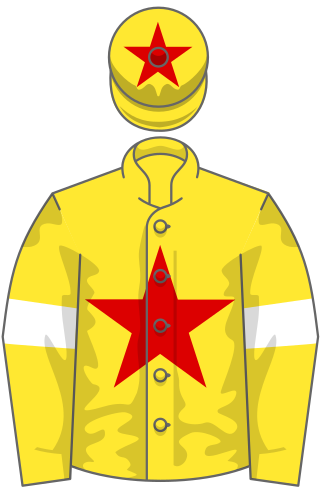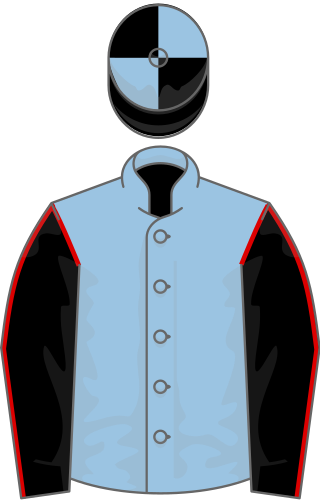Related Research Articles

The Grand National is a National Hunt horse race held annually at Aintree Racecourse, Aintree, Merseyside, England. First run in 1839, it is a handicap steeplechase over an official distance of about 4 miles and 2½ furlongs, with horses jumping 30 fences over two laps. It is the most valuable jump race in Europe, with a prize fund of £1 million in 2017. An event that is prominent in British culture, the race is popular amongst many people who do not normally watch or bet on horse racing at other times of the year.

Golden Miller (1927–1957) was a Thoroughbred racehorse who is the most successful Cheltenham Gold Cup horse ever, winning the race in five consecutive years between 1932 and 1936. He also is the only horse to win both of the United Kingdom's premier steeplechase races - the Cheltenham Gold Cup and the Grand National - in the same year (1934).
In horse racing in Great Britain, France and Republic of Ireland, National Hunt racing requires horses to jump fences and ditches. National Hunt racing in the UK is informally known as "jumps" and is divided into two major distinct branches: hurdles and steeplechases. Alongside these there are "bumpers", which are National Hunt flat races. In a hurdles race, the horses jump over obstacles called hurdles; in a steeplechase the horses jump over a variety of obstacles that can include plain fences, water jump or an open ditch. In the UK, the biggest National Hunt events of the year are generally considered to be the Grand National and the Cheltenham Gold Cup.

The 2001 Grand National was the 154th official running of the Grand National horse race that took place at Aintree Racecourse near Liverpool, England, on 7 April 2001. It went ahead as planned, despite the cancellation of the 2001 Cheltenham Festival, caused by the foot-and-mouth disease crisis.
The 1841 Grand Liverpool Steeplechase was the third official annual running of a steeplechase, later to become known as the Grand National Steeplechase handicap horse race which took place at Aintree Racecourse near Liverpool on 3 March 1841 and attracted a then smallest ever field of 11 runners.
The 1843 Grand Liverpool Steeplechase was the fifth official annual running of a handicap steeplechase, later to become known as the Grand National Steeplechase handicap horse race which took place at Aintree Racecourse near Liverpool on Wednesday 1 March 1843 and attracted a field of 16 runners.
The 1846 Grand Liverpool Steeplechase, later to become known as the Grand National Steeplechase, was the eighth official annual running of a handicap steeplechase. It took place at Aintree Racecourse near Liverpool on 4 March 1846 and attracted a then-record field of 22 entrants. It was won by the unconsidered outsider Pioneer.
The Canal Turn is a fence on Aintree Racecourse's National Course and thus is jumped during the Grand National steeplechase which is held annually at the racecourse, located near Liverpool, England. Named for the Leeds & Liverpool Canal which passes alongside the racecourse at this point, it is jumped twice during the race, as the 8th and 24th fences.
The 1993 Grand National was scheduled on 3 April 1993 to be the 147th running of the Grand National horse race, held annually at Aintree Racecourse near Liverpool, England.
The 1849 Grand National Steeplechase was the 11th official annual running of a handicap steeplechase horse race at Aintree Racecourse near Liverpool on Wednesday, 28 February. It attracted a field of twenty-four competitors for a prize valued at £825.
The 1967 Grand National was the 121st renewal of the world-famous Grand National steeplechase that took place at Aintree Racecourse near Liverpool, England, on 8 April 1967. The race is best remembered for being won by outsider Foinavon at odds of 100/1, after being the only horse to avoid a mêlée at the 23rd fence and jump it at the first attempt.

The 2012 Grand National was the 165th annual renewal of the Grand National horse race at Aintree Racecourse near Liverpool, England. The showpiece steeplechase, which concluded a three-day meeting which is one of only four held at Aintree throughout the year, took place on 14 April 2012. The maximum permitted field of 40 runners ran the last 4 miles 856 yards (7.220 km) of Aintree's National Course featuring 30 fences, competing for record prize money of £975,000, making it the highest-valued National Hunt race in the United Kingdom.
The 1928 Grand National was the 87th renewal of the Grand National horse race that took place at Aintree Racecourse near Liverpool, England, on 30 March 1928.
The 1851 Grand National was, at the time, the 14th renewal of a handicap steeplechase horse race that took place at Aintree near Liverpool, England, on 26 February 1851. However, this was later retrospectively recorded as the 13th official running by the Steeplechase Calendar of 1864 when the race of 1838 was disregarded as official.

Mr Mulligan was an Irish-bred, British-trained Thoroughbred racehorse. He was a specialist steeplechaser who ran twelve times and won seven races under National Hunt rules. After mixed success in Point-to-point, Mr Mulligan rose to prominence by winning five successive races of increasing importance in the 1995/1996 National Hunt season. He became known for his front-running style and occasionally erratic jumping. In the following year he appeared to have lost his form before recording an upset win over a strong field in the 1997 Cheltenham Gold Cup. He was retired after being injured in training in 1998. Eighteen months later he died after being injured in a paddock accident.
Koko was an Irish racehorse who won the 1926 Cheltenham Gold Cup. He finished third in the race in 1928 when odds-on favourite and fell in 1929. He also ran twice without success in the Grand National.

Easter Hero (1920–1948) was an Irish-bred British-trained racehorse who won the Cheltenham Gold Cup in 1929 and 1930 and made three unsuccessful attempts to win the Grand National. He showed little early promise and was passed from owner to owner before beginning to display ability in 1927. Wins in the Becher Chase and the Coventry Chase established him as a leading steeplechaser and he was bought by Alfred Loewenstein with the aim of winning the National. In his first attempt at the race he fell at the eighth and brought the field to a virtual halt after becoming trapped in the ditch in front of the fence.
Limber Hill was a British Thoroughbred racehorse who won the 1956 Cheltenham Gold Cup. He was owned and bred by James Davey and trained in Yorkshire by Bill Dutton. After racing on the point-to-point circuit he then ran over hurdles before becoming a steeplechaser in 1954. He made an immediate impact and won the National Hunt Handicap Chase at the end of his first season. In the 1955/56 National Hunt season he was the leading staying chaser in Britain winning both the King George VI Chase and the Cheltenham Gold Cup. He continued to race until 1958 but his later career was disrupted by injury and he never recovered his best form.
Minella Times is a retired Irish-bred Thoroughbred racehorse who competed in National Hunt racing. In 2021, he won the Grand National under Rachael Blackmore, becoming the first horse ridden by a female jockey to win the race.
Hewick is an Irish-bred and trained Thoroughbred racehorse who races under National Hunt rules. He is a specialist long-distance steeplechaser known for his victories in the 2022 American Grand National and 2023 King George VI Chase.
References
- 1 2 "Tipperary Tim Horse Pedigree". Pedigree Query. Retrieved 26 October 2021.
- 1 2 Norris, William (14 July 2020). The Man Who Fell From the Sky: The Bizarre Life and Death of '20s Tycoon Alfred Loewenstein. CamCat Publishing. p. 68. ISBN 978-0-7443-0079-6.
- 1 2 3 4 5 6 7 Ward, Andrew (16 February 2017). Horse Racing's Strangest Tales. Portico. p. 102. ISBN 978-1-911042-83-9.
- 1 2 3 4 5 6 McNally, Frank (21 July 2016). "Diplomatic nag – An Irishman's Diary about the British ambassador and Tipperary Tim". The Irish Times. Retrieved 26 October 2021.
- 1 2 3 Stewart, Linda (26 March 2016). "Stables housed one of Grand National's most unlikelist winners, 100/1 shot Tipperary Tim". Belfast Telegraph. Retrieved 26 October 2021.
- ↑ Town & Country. Hearst Corporation. 1929. p. 82.
- ↑ Hammond, Gerald (15 April 2016). The Language of Horse Racing. Routledge. p. 244. ISBN 978-1-135-96509-9.
- ↑ Downey, Fairfax (1960). My Kingdom for a Horse. Doubleday. p. 165.
- ↑ King, Brian (7 January 2020). REDISCOVERED DUNDEE. Troubador Publishing Ltd. p. 167. ISBN 978-1-83859-192-2.
- 1 2 Kay, Dr Joyce; Vamplew, Professor Wray (2 October 2012). Encyclopedia of British Horse Racing. Routledge. p. 136. ISBN 978-1-135-76266-7.
- 1 2 McHugh, Susan (2011). Animal Stories: Narrating Across Species Lines. U of Minnesota Press. p. 97. ISBN 978-0-8166-7032-1.
- 1 2 3 Ward, Andrew (16 February 2017). Horse Racing's Strangest Tales. Portico. p. 101. ISBN 978-1-911042-83-9.
- ↑ Norris, William (14 July 2020). The Man Who Fell From the Sky: The Bizarre Life and Death of '20s Tycoon Alfred Loewenstein. CamCat Publishing. p. 67. ISBN 978-0-7443-0079-6.
- 1 2 3 4 Winants, Peter (17 August 2000). Steeplechasing: A Complete History of the Sport in North America. Derrydale Press. p. 210. ISBN 978-1-4617-0822-3.
- ↑ Modern Greats. Timeform. 16 December 2013. p. 321.
- 1 2 Gripper, Ann (13 April 2012). "And they were off! The Grand National in classic Daily Mirror front pages". Daily Mirror. Retrieved 27 October 2021.
- 1 2 3 Roper, Matt (4 April 2019). "The amazing story of Tipperary Tim and the Grand National's biggest ever upset". Daily Mirror. Retrieved 26 October 2021.
- ↑ "1928". Grand National Ultimate History. Retrieved 5 November 2021.
- 1 2 Kay, Dr Joyce; Vamplew, Professor Wray (2 October 2012). Encyclopedia of British Horse Racing. Routledge. p. 147. ISBN 978-1-135-76266-7.
- ↑ Ashforth, David (7 April 2021). "'If he didn't want to listen to you he suddenly wouldn't remember any English' t". Racing Post. Retrieved 26 October 2021.
- ↑ Bird, Thomas Henry (1937). A Hundred Grand Nationals. Country life, Limited; C. Scribner's sons. p. 186.